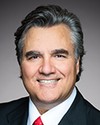Thank you, Mr. Chair.
I'm here today following some recent changes made to Air Canada's fare structure.
I'm accompanied by two members of Air Canada's executive team: Mark Galardo, Air Canada's executive vice-president, revenue and network planning; and David Rheault, Air Canada's vice-president, government relations.
I am sorry not to be speaking to you in French. I am still taking courses, but at my age it's difficult. Thank you for your understanding.
Before providing more detail on our recent changes, it is important to underline the context in which these changes were made, a context that is characterized by solid competition in the domestic market, which means lower prices, more choice for passengers and increased pressure on carriers to compete more effectively. The changes we have announced have been and will continue to be communicated to our customers with the utmost transparency.
The growth of airlines such as WestJet and Porter and the entry of Flair have profoundly changed the market dynamic. Over the last 10 years, the proportion of domestic routes where three carriers compete has more than tripled, reaching 54% in 2023, the same proportion as that of the United States. There is no doubt this increased competition has driven air fares down.
Since 2011, according to an analysis by Intervistas based on data from Sabre, the average fare in the domestic market has been reduced by about 20% in constant dollars. During the same period, the number of domestic passengers has increased by about 27%. More people are travelling, and people are paying less for their tickets. As a reminder, the average domestic fare had already gone down by about 35% in constant dollars between 1990 and 2001, according to Stats Canada.
In this context, airlines must evolve their offerings to meet the changing needs of passengers. Part of this evolution, which is to benefit passengers, has been the unbundling of fares, which allows passengers to buy only the features that they are interested in.
Today, Air Canada offers a range of fare options tailored to different preferences, including, or not, services such as checked baggage, ticket changes, refundability and on-board meals. This provides customers the flexibility to choose the options most important to them while enabling Air Canada to compete effectively. Our recent change to Air Canada's lowest fare, the basic fare, which no longer includes carry-on baggage, represents another step in this direction. With online tools and price comparison platforms, shopping for fares has never been easier. Consumers can readily identify the lowest fares available.
True competition requires companies to respond to market forces. This is exactly what we're doing. We are aligning our lowest-fare policies with those already offered by our competitors—WestJet, Porter and Flair—to be in a better position to compete for price-conscious customers. By doing this, Air Canada is ensuring consistency for consumers when comparing fares across airlines. It is important to note that all other Air Canada fare types continue to include free carry-on baggage. It is also included in all fare types, including basic, for markets other than North America and sun destinations.
This committee would like to continue the discussion around affordability. I encourage you to revisit your previous recommendations, which include a review of all costs imposed by the government on airports and airlines and the reinvestment of all rents collected back into the airport infrastructure. Currently, taxes and government-imposed fees represent about 30% of the average domestic fare. If these fees were lowered, it would make a tangible difference for people travelling in Canada.
In today's competitive environment, Air Canada must respond to real-time dynamics to remain a competitive option for travellers. Similar fare structures at other carriers have not raised concerns from Parliament. Travellers tend to prioritize the lowest advertised price even if additional fees make the final cost higher, and small differences in pricing can determine whether we are considered at all.
We will all probably agree that competition is the best way to ensure the best service and prices for Canadians. It does that by allowing customers to compare products and by letting the market decide which will succeed and which are not wanted. To remain competitive, we must ensure our fares are comparable with those of our competitors while offering travellers the flexibility to pay only for the services they value.
Our goal is to provide affordable options without compromising on the quality of service, ensuring that Air Canada remains an accessible and competitive choice for Canadian travellers.
We are available to take questions.
Thank you.



